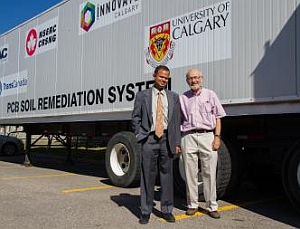
Gopal Achari, left, and Cooper Langford in front of their mobile PCB clean-up unit (Riley Brandt, University of Calgary)
A team of engineers and chemists at University of Calgary in Alberta, Canada devised a new process for cleaning soil contaminated with polychlorinated biphenyls or PCBs, cancer-causing chemicals banned in the U.S. since 1979, but with residues still in the environment. The new methods, say Calgary engineering professor Gopal Achari and chemistry professor Cooper Langford, use ultraviolet light and are safer and less expensive than current incineration processes.
PCBs are a form of chlorinated hydrocarbons manufactured in the U.S. since 1929 that are non-flammable, chemically stable, and good electrical insulators. Until they were banned in 1979, PCBs were found in a wide range of commercial and industrial products, including paints, plastics, electrical transformers, cable insulation, and adhesives. The U.S. Environmental Protection Agency says PCBs are shown to cause cancer, as well as adverse effects on human immune, reproductive, nervous, and endocrine systems.
Despite being banned for more than 30 years, PCBs still enter the environment from illegal or poorly maintained hazardous waste sites, as well as leaks from old electrical transformers, and disposal of consumer products with PCBs into municipal landfills not designed for hazardous wastes. Because of their chemical stability, PCBs do not easily break down in the environment and may remain for long periods of time cycling between air, water, and soil.
Canada has two disposal sites for PCBs in Alberta and Quebec, which require digging up and shipping contaminated soil to those sites, where the PCBs are destroyed in special incinerators. Not only is digging up, transporting, and burning the PCB-laden soil environmentally risky, it’s expensive. The university says current disposal methods can cost as much as $1,000 per metric ton (1,000 kilograms or 2,205 pounds).
Achari and Langford’s system treats the contaminated soil using ultraviolet light to chemically degrade the PCBs so the contaminated soil can be cleaned and returned to the same site without transporting or burning. The Calgary researchers estimate treating contaminated soil with their process at commercial scale will cost from $350 to $500 a metric ton, about half to a third of current treatment costs.
The research team is partnering with energy company TransCanada Corp. and Alberta construction services company IPAC Services, as well as SAIT Polytechnic in Calgary and Innovate Calgary — the university’s technology transfer office — to build a mobile demonstration unit to field test the new PCB clean-up process. The demonstation unit is housed inside a 15-meter shipping container (pictured at top).
TransCanada contibuted about half of the $1 million cost of the project and is taking part in the field tests. Innovate Calgary is seeking a Canadian patent for the process.
Read more:
- Hydrogen Fuel Cells Found Feasible for Ships Docked in Port
- More Feasible CO2 Emission Control Technology Devised
- Analysis Shows Life-Cycle Impacts of Lithium-Ion Batteries
- Purdue Licenses Reagent for Safer Fluorine Compounds
- Solar Nanoscale Protein Filter Cleans Antibiotics from Water
* * *

 RSS - Posts
RSS - Posts
You must be logged in to post a comment.